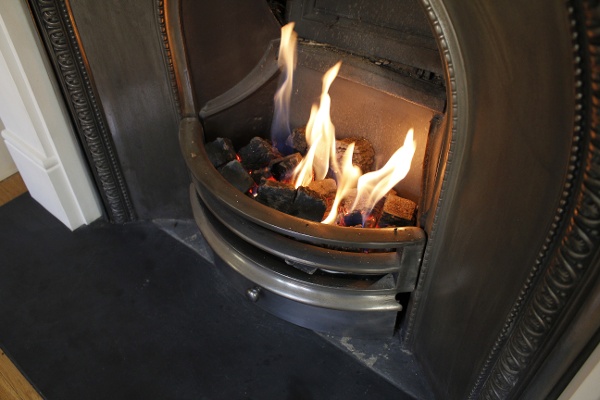
There are a lot of heating options for a new build house. Deciding on the best option is not necessarily straightforward and needs to be done with consideration with the...
The biggest expense in a conventional home is heating, which works by integrating central heating with the hot water system. A low energy home's insulation slashes the heating bill to leave hot water as the biggest expense, but also removes the need for a central heating system that the hot water can be integrated with.
Before plunging into the specific differences, it's worth asking how hot we're talking when we talk about hot water. There are a number of guidelines published by BEAMA Ltd, but the salient point here is that hot water must be above 60°C (140°F) to kill off any legionnaire's disease bacteria that find their way in. That's hot enough to scald and the UK building regulations Part G state that it must be down to no more than 48°C (118°F) when it comes out of the tap, so it's helpful that the TMVA document describes the intricacies of distributing hot water around a building in a way that boils legionnaire's disease without boiling body parts.
A key difference between conventional and low energy homes lies in how well they retain heat. Most conventional homes are not particularly well sealed so even if they are well insulated, the air warmed by the central heating is constantly leaking out of the fabric and being replaced with colder air from outside. They need constant heating to keep up with the chilly inflow, which they achieve by pumping hot water around the building and using radiators or underfloor heating to release the heat into the air. We can live with the radiators taking their time to heat up and to cool down as long as they pump out a constant supply of heat.
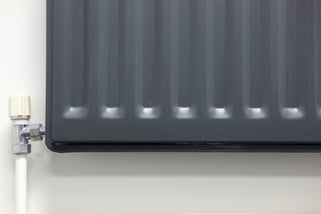 Given that water needs to be constantly heated to supply the central heating, it makes sense to use the same system to supply the hot water to the taps. Hence most conventional homes use a combi boiler that runs the central heating and hot water simultaneously.
Given that water needs to be constantly heated to supply the central heating, it makes sense to use the same system to supply the hot water to the taps. Hence most conventional homes use a combi boiler that runs the central heating and hot water simultaneously.
In a low energy home, the better insulation eliminates the need for constant heating. Rooms can be heated with infra-red or convection heaters that only need to be on for a few minutes at a time and then switch off as soon as they hit the temperature on the thermostat. That's good news for cutting down the heating bill, but means we have to look for alternative ways to heat the water. Fortunately, we have a few to choose from.
Most conventional homes heat water using mains gas, or oil if they're not connected. One way of keeping a low energy home's energy demands appropriately low is to generate at energy on site. Because most systems for on-site generation are dependent on the weather or the time of day, the hot water system is still connected to the gas main in case everyone decides to have a shower at a time when no power is being generated on site, but a good building control system can make the most of the on-site power and keep the gas bill to the bare minimum.
The best way to generate energy on-site will depend on the size and location of the home. There are a number of options to choose from, which include:
There are various designs of solar collector, all based on a black panel that absorbs solar heat and transfers it to narrow tubes full of water. 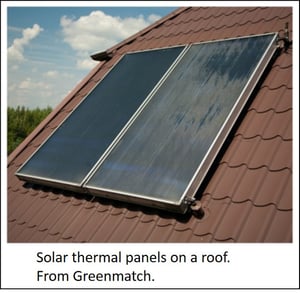 The water it heats circulates through a heat exchanger that passes the heat to the water in the tank and sends cooler water back to the collector. Solar thermal is likely to be the most efficient way of generating hot water on-site in most situations.
The water it heats circulates through a heat exchanger that passes the heat to the water in the tank and sends cooler water back to the collector. Solar thermal is likely to be the most efficient way of generating hot water on-site in most situations.
The classic solar panel is usually the first thing to come to mind when we talk about solar power. A panel of photovoltaic cells on the roof can generate electricity for the home and although an electric element is not the most efficient way to heat water, it can use any solar energy left over when the panels are already powering the other electrical needs of the home.
There's heat energy for the taking in the air around us, which can be harvested to heat our water. Because there's energy in the air at any temperature above absolute zero (-273°C/-460°F), an ASHP can extract heat energy from air that is considerably colder than the water it needs to heat. The downside of using heat pumps is that they need mains electrical power so we can only say they're generating energy onsite if they're putting more heat energy into the water supply than if the same amount of electricity had been used to heat the water directly.
A Canadian government study [PDF] showed that air source heat pumps still generated heat in the depths of winter which, being Canada, sank as low as -25°C (-13°F). However, the efficiency of the pumps dropped off markedly below freezing point and the study concluded that the electricity used to run an ASHP cost about twice as much as heating water with the mains gas during winter, although the ASHP did beat mains gas at summer temperatures. The difference between gas and electricity prices in the UK is similar to the difference in Canada, although there aren't many parts of Britain that spend as much time below freezing point as there are in Canada.
An ASHP's efficiency is inevitably limited by the fact that we'll want hot water from our ASHP whether it's draped with icicles in February or baking in a July heatwave, so it can't be optimised for any one temperature.
While air temperatures fluctuate by tens of degrees between day and night, let alone between winter and summer, the temperature a few metres underground is fairly constant at around 10°C (50°F) in most of the UK. GSHPs use that by pumping water through a buried pipe to bring it to that temperature before passing it through the heat exchange system. It doesn't need to cope with the same highs and lows as an ASHP, which means it can be tweaked for better efficiency.
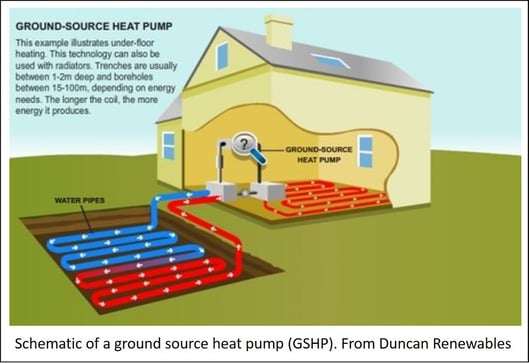 On the downside, GSHPs need to be installed in a trench or borehole, so they'll only work in a home with at least a small garden to put them under. That also means that the installation costs more than an ASHP, as is the maintenance because it's harder to get at where any problem is likely to be.
On the downside, GSHPs need to be installed in a trench or borehole, so they'll only work in a home with at least a small garden to put them under. That also means that the installation costs more than an ASHP, as is the maintenance because it's harder to get at where any problem is likely to be.
The Energy Saving Trust field-tested air- and ground- source heat pumps and reported [PDF] that over 80% of the people who used them for water heating were happy with them. More to the point, they found that GSHPs were more efficient than ASHPs, and returned between two and three times as much energy as was used to power them.
Unfortunately, the study didn’t compare the cost or efficiency of GSHPs with mains gas. Electricity is around four times more expensive than gas per unit of energy, which is why most conventional homes use gas rather than electricity to heat their water.
The upshot is that even if you have one of the more efficient GSHPs, it's a more expensive way to heat your water than mains gas even before you factor in the installation and maintenance costs. They're only worth considering for homes that are not on the gas main.
A heat pump is always going have a temperature at which it works best, so an alternative approach to using the air or ground temperature is to take advantage of a consistent source of heat in any home that's lived in: the home itself, which we endeavour to keep at a constant temperature in defiance of the vagaries of season and weather.
Being well insulated, a low energy home can't depend on air leaking through the walls to get rid of the smell of us living in it, not to mention the carbon dioxide we breathe out while we're doing the living. Extractor fans can dump the lived-in air outside to make space for fresh air to come in, but we don't have to dump the heat with it. The ventilated air can be run through a heat pump on its way out, passing the heat we've already paid for into the hot water and venting the cool air back outside.
The commonest type of solid fuel power system is a wood burning stove, though any solid fuel system can be connected to a back boiler: a pipe that runs from the hot water 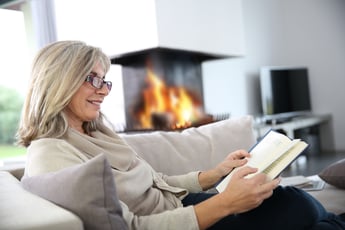 tank through the stove. The back boiler performs a secondary function the stove is likely to produce more heat than is needed to heat a low energy home so it needs somewhere to dump it if it’s not to turn the home into an oven.
tank through the stove. The back boiler performs a secondary function the stove is likely to produce more heat than is needed to heat a low energy home so it needs somewhere to dump it if it’s not to turn the home into an oven.
Wood burners are likely to be at their best in a house in the countryside, which may not be connected to the gas main but where there's no shortage of dead wood to be picked up
Low energy homes have benefitted from several innovations in water supply and storage over the last few decades. The water mains are now so reliable that there's no need to keep a cold-water tank in the loft to maintain the pressure. Many buildings still have them, but that's a sign that it's been a long time since their last renovation.
A conventional family home's taps now take their cold water straight from the mains while a combi boiler supplies as much hot water as is needed. That has the advantage of not needing hot water storage on site, but the boiler heats the water as it's used so it has to be able to keep up. It's fine in a typical family home with one bathroom but in a larger building with several bathrooms, it's likely to leave you trying to wash off the soap with a dribble of lukewarm water when someone else turns another shower on.
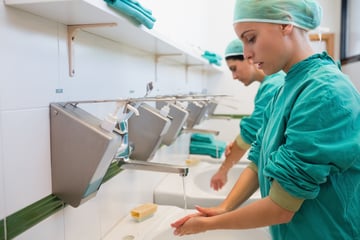 The solution to that problem has been around since the mid-1980s: Heatrae Sadia's Megaflo unvented cylinder stores hot water on site while maintaining the mains pressure. Although a range of unvented tanks is available now, the brand name of 'Megaflo' is often used to describe them all. Unvented cylinders come in various sizes depending on how many showers it needs to supply at the same time, but choosing the right size will put an end to dribbling showers for good.
The solution to that problem has been around since the mid-1980s: Heatrae Sadia's Megaflo unvented cylinder stores hot water on site while maintaining the mains pressure. Although a range of unvented tanks is available now, the brand name of 'Megaflo' is often used to describe them all. Unvented cylinders come in various sizes depending on how many showers it needs to supply at the same time, but choosing the right size will put an end to dribbling showers for good.
Unvented cylinders are key to low energy homes, as they let us make the physics of water work for us. Water is very good at storing heat energy: once it's heated it stays hot, as anyone who has run their bath too hot and waited for it to cool down will have discovered at about the time they get tired of waiting and run some cold water into it. The fact that hot water stays hot is the reason it's possible to heat it using some of the systems above that only run some of the time. A solar thermal system might only be able to heat water during the daylight hours but you can still have a hot shower at three in the morning if your shift forces you to.
Keeping energy costs low is not only a matter of how the heat is generated but also of fine control for maximum efficiency. At its most basic, the control would be a thermostat on the shower to mix the hot and cold water so that what comes out of the shower head is just right. If you're heating water by running your wood burning stove every Sunday, the water in the tank will be hotter on Monday than on Friday and you don't want to watch it running down the drain while you have a daily fiddle with the taps to get it to the right temperature.
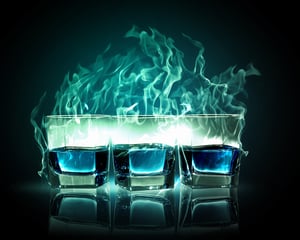 A more advanced control system will go further than that, controlling how the water is heated in the first place. When hot water is used, cold water flows into the tank which lowers the water temperature. We have a case study of such a system installed in a renovated house that used solar thermal water heating.
A more advanced control system will go further than that, controlling how the water is heated in the first place. When hot water is used, cold water flows into the tank which lowers the water temperature. We have a case study of such a system installed in a renovated house that used solar thermal water heating.
A conventional thermostat control will immediately trigger heating with the mains gas to heat it back to the temperature it's set at, irrespective of any on-site generation system you may have. That means that if you take that shower at 3 am, you might leave the cylinder temperature safely above 60°C but the gas heating would still kick in immediately. The thermostat wouldn't know about the solar thermal system that would do the job as soon as the sun comes up without burning gas you'll have to pay for.
A building control system will burn no more gas than is needed to keep the water above the critical 60°C and wait for sunrise to do the rest of the work without appearing on your energy bills.
Next steps
If you would like to understand more about how to provide energy efficient hot water in your project, please book an appointment with one of our consultants:
If you have more questions about heating water for a low energy building, ask us using the form below and we'll answer them.

There are a lot of heating options for a new build house. Deciding on the best option is not necessarily straightforward and needs to be done with consideration with the...
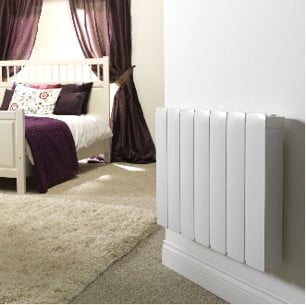
There are many innovations transforming building services driven mainly by the huge challenge of achieving Net Zero targets. In a series of articles, we look at these...